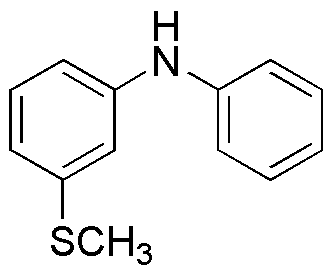3-(Methylthio)-N-phenylaniline is widely utilized in research focused on:
- Dyes and Pigments: This compound is used in the synthesis of various dyes, providing vibrant colors for textiles and plastics, enhancing aesthetic appeal and marketability.
- Pharmaceuticals: It serves as an intermediate in the production of pharmaceutical compounds, contributing to the development of medications with specific therapeutic effects.
- Agrochemicals: The chemical plays a role in formulating agrochemicals, aiding in the development of effective pesticides and herbicides that improve crop yield and protection.
- Polymer Chemistry: It is utilized in creating specialty polymers, offering properties such as improved durability and resistance to environmental factors, which are crucial for various industrial applications.
- Research and Development: In academic and industrial labs, this compound is valuable for studying chemical reactions and properties, helping researchers innovate new materials and processes.
General Information
Properties
Safety and Regulations
Applications
3-(Methylthio)-N-phenylaniline is widely utilized in research focused on:
- Dyes and Pigments: This compound is used in the synthesis of various dyes, providing vibrant colors for textiles and plastics, enhancing aesthetic appeal and marketability.
- Pharmaceuticals: It serves as an intermediate in the production of pharmaceutical compounds, contributing to the development of medications with specific therapeutic effects.
- Agrochemicals: The chemical plays a role in formulating agrochemicals, aiding in the development of effective pesticides and herbicides that improve crop yield and protection.
- Polymer Chemistry: It is utilized in creating specialty polymers, offering properties such as improved durability and resistance to environmental factors, which are crucial for various industrial applications.
- Research and Development: In academic and industrial labs, this compound is valuable for studying chemical reactions and properties, helping researchers innovate new materials and processes.
Documents
Safety Data Sheets (SDS)
The SDS provides comprehensive safety information on handling, storage, and disposal of the product.
Product Specification (PS)
The PS provides a comprehensive breakdown of the product’s properties, including chemical composition, physical state, purity, and storage requirements. It also details acceptable quality ranges and the product's intended applications.
Certificates of Analysis (COA)
Search for Certificates of Analysis (COA) by entering the products Lot Number. Lot and Batch Numbers can be found on a product’s label following the words ‘Lot’ or ‘Batch’.
Número de catálogo
Número de lote/lote
Certificates Of Origin (COO)
This COO confirms the country where the product was manufactured, and also details the materials and components used in it and whether it is derived from natural, synthetic, or other specific sources. This certificate may be required for customs, trade, and regulatory compliance.
Número de catálogo
Número de lote/lote
Safety Data Sheets (SDS)
The SDS provides comprehensive safety information on handling, storage, and disposal of the product.
DownloadProduct Specification (PS)
The PS provides a comprehensive breakdown of the product’s properties, including chemical composition, physical state, purity, and storage requirements. It also details acceptable quality ranges and the product's intended applications.
DownloadCertificates of Analysis (COA)
Search for Certificates of Analysis (COA) by entering the products Lot Number. Lot and Batch Numbers can be found on a product’s label following the words ‘Lot’ or ‘Batch’.
Número de catálogo
Número de lote/lote
Certificates Of Origin (COO)
This COO confirms the country where the product was manufactured, and also details the materials and components used in it and whether it is derived from natural, synthetic, or other specific sources. This certificate may be required for customs, trade, and regulatory compliance.


